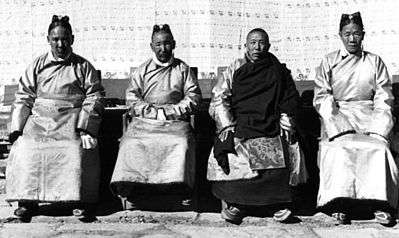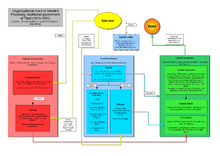Kashag
The Kashag (Tibetan: བཀའ་ཤག ་, Wylie: bkaʼ-shag, ZYPY: Gaxag, Lhasa dialect: [ˈkáɕaʔ] ; Chinese: 噶廈; pinyin: gáxià), was the governing council of Tibet during the rule of the Qing dynasty and post-Qing period until the 1950s. It was created in 1721,[1] and set by Qianlong Emperor in 1751 for the Ganden Phodrang in the 13-Article Ordinance for the More Effective Governing of Tibet《酌定西藏善后章程十三条》. In that year the Tibetan government was reorganized after the riots in Lhasa of the previous year. The civil administration was represented by Council (Kashag) after the post of Desi (or Regent; see: dual system of government) was abolished by the Qing imperial court. The Qing imperial court wanted the 7th Dalai Lama to hold both religious and administrative rule, while strengthening the position of the High Commissioners.[2][3][4][5]
.jpg)

As specified by the 13-Article Ordinance for the More Effective Governing of Tibet, Kashag was composed of three temporal officials and one monk official. Each of them held the title of Kalön (Tibetan: བཀའ་བློན་, Wylie: bkaʼ-blon, Lhasa dialect: [kálø ̃] ; Chinese: 噶倫; pinyin: gálún), sought appointment from the Qing imperial court, and the Qing imperial court issued certificates of appointment.[2]
The function of the Council was to decide government affairs collectively,[2] and present opinions to the office of the first minister. The first minister then presented these opinions to the Dalai Lama and, during the Qing Dynasty the Amban, for a final decision. The privilege of presenting recommendations for appointing executive officials, governors and district commissioners gave the Council much power.
On 28 March 1959, Zhou Enlai, the premier of the People’s Republic of China (PRC), formally announced the dissolution of the Kashag.[6]
Ministries

Headed by the Council was the government administration, divided into ministries: political, military, economic, judicial, foreign, financial and educational departments. Except for the Ministry of Finance (Tibetan: རྩིས་ཁང་, Wylie: rtsis-khang, Lhasa dialect: [tsíkaŋ] ; Chinese: 商上; pinyin: shāngshàng), all ministries had two representatives – one temporal and one monastic. The Ministry of Finance had three lay officials. Each of them held the title of Tsipön (Tibetan: རྩིས་དཔོན་, Wylie: rtsis-dpon, Lhasa dialect: [tsípø ̃] ; Chinese: 仔琫; pinyin: zīběng). All ministries had a right to make decisions to the extent of their competence. Matters, or problems outside the competence of ministries were (with a particular ministry’s given opinion) presented to the Council. Everything outside the competence of the Council was presented to the Dalai Lama himself.
Central Tibetan Administration
The Kashag has been maintained to the present time by the Central Tibetan Administration, the government-in-exile maintained in Dharamsala, India. The head of the Kashag was known as Kalön Tripa until September, 2012, when the title was changed to Sikyong. This position, sometimes referred to informally as the prime minister of the Tibetan government-in-exile, became an elected position in 2001. In 2011, shortly after the election of Lobsang Sangay and upon the resignation of the Dalai Lama as the overall leader of the CTA, the head of the Kashag became the highest political official in the Tibetan exile community.
According to Michael Backman, notable past members of the Cabinet include Gyalo Thondup, the Dalai Lama's eldest brother, who served as Chairman of the Cabinet and as Minister of Security, and Jetsun Pema, the Dalai Lama's younger sister, who served variously as Minister of Health and of Education.[7]
- Lobsang Sangay - Prime Minister, Sikyong and Minister for Education
- Dolma Gyari - Minister for Home
- Dicki Chhoyang - Minister for Information & International Relations
- Pema Chinnjor - Minister for Religion & Culture
- Ngodup Drongchung - Minister for Security
- Tsering Dhondup - Minister for Finance
- Tsering Wangchuk - Minister for Health
References
- Dawa Norbu, China's Tibet Policy
- Jiawei Wang; Gyaincain Nyima; Jiawei Wang (1997). The Historical Status of China's Tibet. pp. 58–. ISBN 978-7-80113-304-5.
- Seventh Dalai Lama Kelsang Gyatso Archived 2010-07-01 at the Wayback Machine
- The Dalai Lamas of Tibet, p. 101. Thubten Samphel and Tendar. Roli & Janssen, New Delhi. (2004). ISBN 81-7436-085-9.
- Tsepon W. D. Shakabpa, Tibet, a Political History (New Haven: Yale, 1967), 150.
- https://sites.fas.harvard.edu/~hpcws/jcws.2006.8.3.pdf
- Backman, Michael (2007-03-23). "Behind Dalai Lama's holy cloak". The Age. Retrieved 2010-11-20.
See also
- Ganden Phodrang
- Chinese expedition to Tibet (1720)
- Tibet under Qing rule
- Dual system of government